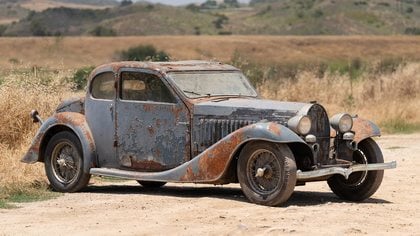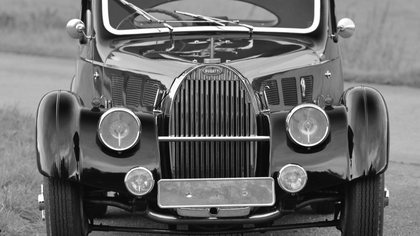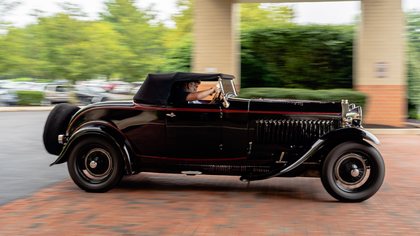Description
The Aerolithe is the Bugatti that never was, or at any rate, for a very short time. However, the Aerolithe evolved into one of the most mythical of all Bugatti coupes, the Atlantic.
The Aerolithe was designed by Jean Bugatti, son of Ettore Bugatti, and presented in October 1935 at the auto shows of Paris and London. According to history, the body was dismantled shortly afterwards with some of the parts from the Aerolithe being used for the first Atlantic as ordered by Lord Rothschild in 1936.
In the early 2000s this magnificent tribute to the Aerolithe was orchestrated and crafted in Germany using Chassis 57645 as the base. Clearly a labor of love, the project involved many skilled craftsmen working their magic to create the full alloy bodywork.
The base for the project is chassis 57645 which was originally delivered as a T57 Cabriolet with bodywork by Letourneur & Marchand. Later, in 1954, Ch. 57645 was sold to Jacques Brown, a French sculptor, who replaced the original bodywork with a streamlined design of his own design. One of two aerodynamic bodies designed by Jacques Brown, both were exhibited at the 1955 Salon de l’ Automobile, however none of them sold.
The Jacques Brown bodywork was later removed from Ch. 57645 and is now displayed at the Museum Autoworld in Belgium.
Move forward many years to July 2004 when work on the Aerolithe project was initiated, working from the partially restored chassis 57 645.
Many modifications were made to get the details correct, including shortening the length of the chassis and moving back the engine, firewall, and radiator 105mm.
The full alloy bodywork was carefully crafted by ‘Karroseriebau Eckhardt Melchior’ in Germany and then assembled using some 1200 rivets to assemble the body parts.
As very little is known about the original interior of the Aerolithe, the interior was constructed with a mottled alloy dashboard as a nod to the GP cars of the era and with chrome rail and leather upholstery seating as in the Atlantic.
The fully rebuild engine is believed to be from a T57S and is fitted with a Stromberg UUR-2 carburetor as per factory specification. With a capacity of 3. 3Litre, the straight-eight twin overhead camshaft engine gives approximately 175HP, more than plenty to propel this wonderful Bugatti up to modern highway speeds and then some.
The Aerolithe was finished in the spring of 2006 and participated in many rallies and shows over the years. In 2019 the car was purchased by a car collector in Denmark, who was intrigued by the story and craftmanship of the Aerolithe project.
Since then, the T57 Aerolithe has been used occasionally and always enthusiastically by the current owner and has benefitted from regular service and maintenance with his in-house mechanic. The spats for the rear wheels are with the car but currently not fitted.
The Bugatti comes with a current UK V5 and is ready to be enjoyed on the road.
For registration within the EU, the car will be exempt from EU import tax, as it has resided in EU prior to Brexit.
















